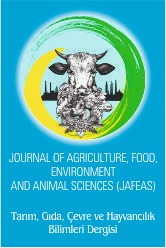A Field Study on The Major Economic Activities of The Yoruks and Their Expectations from The Future
Main Article Content
Abstract
This study was carried out in 2019 order to obtain the current information about the livestock activities, which constitute the main sources of income of the Yoruks, which still exist in the Mediterranean and Eastern Anatolia regions. This study was carried out in 60 enterprises that are still engaged in nomadic stockbreeding. 28 open-ended questions were asked in the questionnaire. In this study, various data about Yoruk were collected through observation, questionnaire and interview. The answers to the open-ended questions were evaluated in the study. During the interviews, audio recordings were taken with permission. In addition, various visuals of the culture of the bearers were also photographed. When the data obtained from the study are evaluated, it is seen that today and still the verbal and practical knowledge they have learned from their ancestors in animal breeding and animal feeding subjects, which are the main economic activities of the participants. The most distinctive features of the judges are that they define themselves as people who can solve all kinds of problems. However, especially young people do not want to be nomadic in the future. As a reason for this situation, they show the problems they experienced in education, low income, high cost of animal feed, lack of state support for the participants, lack of communication problems such as telephone and internet in pasture, highland and overwintering areas.
Article Details
References
Can D., 2015. Yayla hayvancılığında verimli yaşam ve göç yolları. Toros Yörüklerinin Yaşamsal Sorunları Sempozyumu. 8 Mayıs 2015. Mersin Üniversitesi Kongre Merkezi. Mersin.
Coşgun U, Yılmaz M., 2018. The pasturing routes of nomadic people and their problems (Case Study: Konya and Muğla Regional Directorates of Forestry). 1st International Symposium on Silvopastoral Systems and Nomadic Societies in Mediterranean Countries. 22-24 October 2018, Isparta/Turkey.
Doğan C, Doğan MS., 2005. Yörüklerin hayat tarzı. Sosyal Siyaset Konferansları Dergisi, 49: 677-708.
Ekiz E, Yazıcı H., 2018. Nomadic communities living in forest (Resources) in upper basins of the Western Mediterranean Region. 1st International Symposium on Silvopastoral Systems and Nomadic Societies in Mediterranean Countries. 22-24 October 2018. Isparta/Turkey.
Ekiz E., Yazıcı H., 2014. Kültürel coğrafya açısından Burdur?un Bucak ilçesi ve köylerindeki yörük göçleri. Coğrafyacılar Derneği Uluslararası Kongresi Bildiriler Kitabı, 4-6 Haziran 2014, Muğla, Türkiye, S. 175-184.
Eröz M., 1991. Yörükler. Türk Dünyası Araştırmaları Vakfı Yayını, İstanbul.
Finn S, Herne M, Castille D., 2017. The value of traditional ecological knowledge for the environmental health sciences and biomedical research. A Section 508?conformant HTML version of this article is available at https://doi.org/10.1289/EHP858.
Güneş G. ve Büyükşahin F., 2016. The importance of traditional ecological knowledge: The case of Sarikecili Yoruks, Hacettepe Üniversitesi Sosyolojik Araştırmalar E-Dergisi, ISSN1304-2823.
Harunoğulları M, Polat Y., 2018. Mersin-Arslanköy yörüklerinin yaylacılık faaliyetleri ve sorunları. Ege Coğrafya Dergisi, 27 (1): 71-86.
Johannes RE., 1993. Integrating traditional ecological knowledge and management with environmental ımpact assessment. Traditional Ecological Knowledge: Concepts and Cases, 1: 33-39.
Karabaşa S., 2019. Kaş-Kekova özel çevre koruma bölgesindeki geleneksel kültürün kültür-çevre ilişkileri açısından değerlendirilmesi. Folklor/edebiyat, 25 (97): 207-227.
Kılıç T., 2014. Karacadağ?da göçebe hayvancılık ve göçerler. Fırat Üniversitesi Sosyal Bilimler Dergisi, 24 (2): 1-12.
Özalp M, Sütlü E., 2011. Fırtına havzası?nın yukarı bölümlerinde yürütülen yaylacılık faaliyetlerinin zamansal değişiminin irdelenmesi ve bazı çevresel sorunların tespiti. Artvin Çoruh Üniversitesi Orman Fakültesi Dergisi, 12(2):148-160.
Savaş İ, Yılmaz İ, Yanar M., 2019. Iğdır İlinde göçer hayvancılık ve bazı yapısal özellikleri. Iğdır Üniversitesi Fen Bilimleri Enstitüsü Dergisi, 9(1): 552-561.
Şimşek B., 2017. Yörüklerin sorunlarına ilişkin gündem dışı konuşması. https://www.tbmm.gov.tr/develop/owa/genel_kurul.cl_getir?pEid=61252. Erişim:16.06.2019.
Tapur T., 2009. Abanoz yaylası. Selçuk Üniversitesi Sosyal Bilimler Enstitüsü Dergisi, 21: 473-487.
Türkay C., 1979. Başbakanlık arşiv belgelerine göre Osmanlı imparatorluğunda oymak, aşiret ve cemaatler. İstanbul, Tercüman Gazetesi Yayınları.
Yılmaz M, Coşgun U., 2017. Konar-Göçer yörüklerin otlatma sorunları ve çözüm önerileri (Mersin ve Konya Orman Bölge Müdürlükleri Örneği). P:51-64. IV. Ulusal Ormancılık Kongresi. 15-16 Kasım 2017, Antalya.
